Annotated Bibliography: Evaluating Business Graduate Employability
VerifiedAdded on 2022/11/29
|18
|3653
|438
Annotated Bibliography
AI Summary
This annotated bibliography presents five journal articles related to the work readiness of business graduates. Each entry includes full reference details, the aim of the research, methodology, participant information, key findings, strengths and weaknesses, conclusions, and relevance to the research question of whether business students are work-ready. The articles cover various aspects of employability, including the importance of non-technical skills, the impact of work-integrated learning, the expectations and perceptions of management students, and the assessment of employability skills. The studies employ both qualitative and quantitative research methods, involving students and academics from different countries. The analysis highlights the need for universities to prepare graduates for the workplace, focusing on both hard and soft skills, and the importance of practical experience.
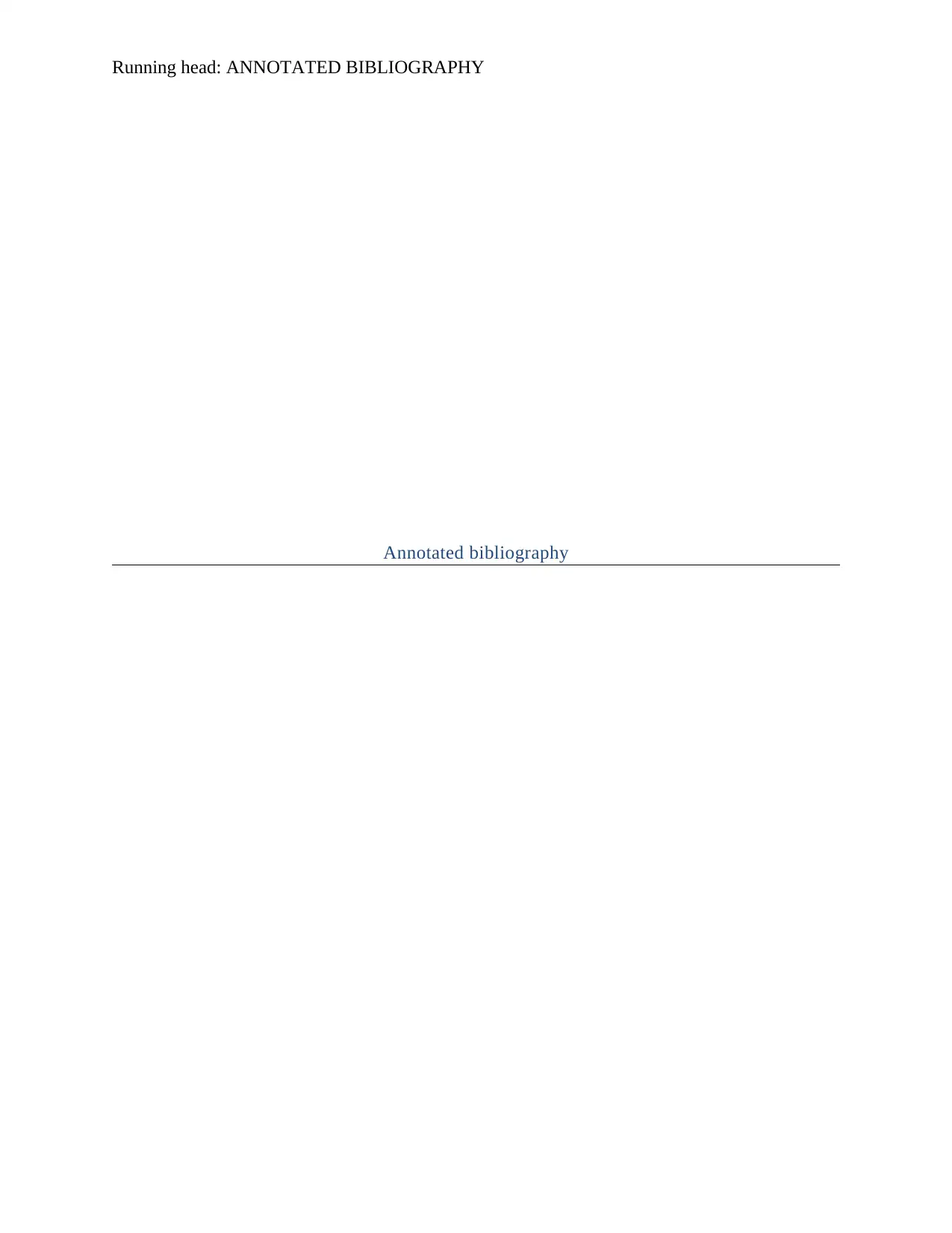
Running head: ANNOTATED BIBLIOGRAPHY
Annotated bibliography
Annotated bibliography
Paraphrase This Document
Need a fresh take? Get an instant paraphrase of this document with our AI Paraphraser
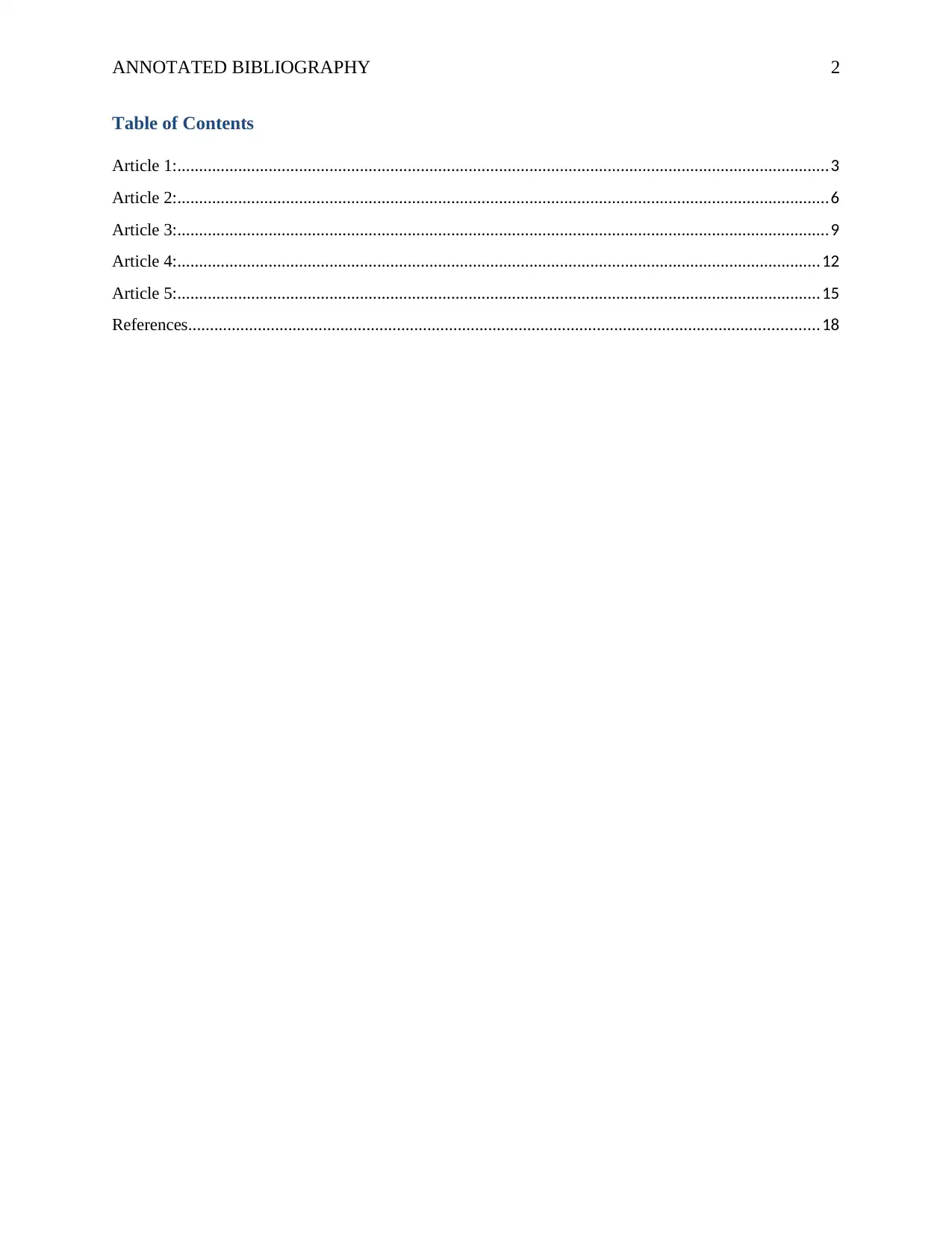
ANNOTATED BIBLIOGRAPHY 2
Table of Contents
Article 1:......................................................................................................................................................3
Article 2:......................................................................................................................................................6
Article 3:......................................................................................................................................................9
Article 4:....................................................................................................................................................12
Article 5:....................................................................................................................................................15
References.................................................................................................................................................18
Table of Contents
Article 1:......................................................................................................................................................3
Article 2:......................................................................................................................................................6
Article 3:......................................................................................................................................................9
Article 4:....................................................................................................................................................12
Article 5:....................................................................................................................................................15
References.................................................................................................................................................18
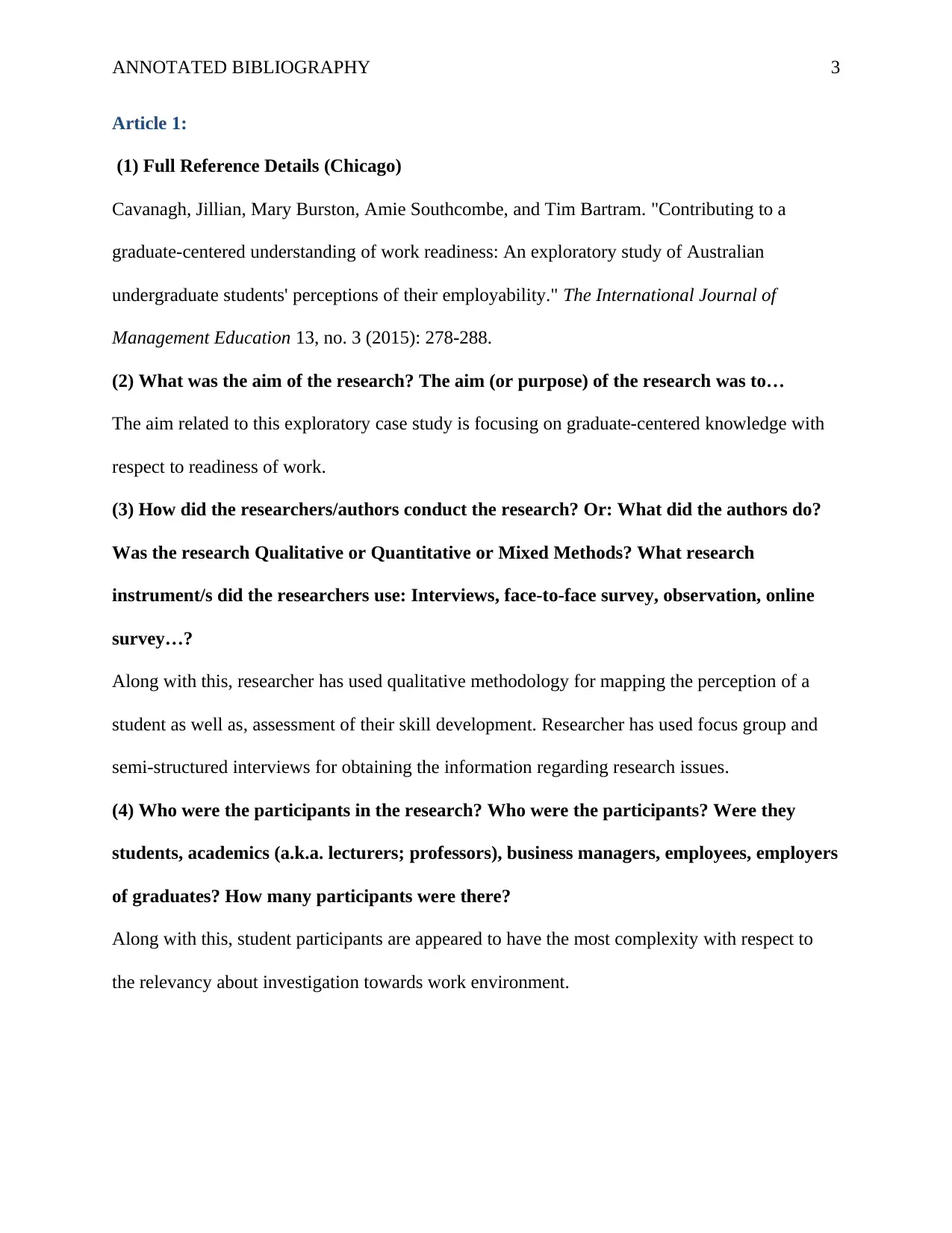
ANNOTATED BIBLIOGRAPHY 3
Article 1:
(1) Full Reference Details (Chicago)
Cavanagh, Jillian, Mary Burston, Amie Southcombe, and Tim Bartram. "Contributing to a
graduate-centered understanding of work readiness: An exploratory study of Australian
undergraduate students' perceptions of their employability." The International Journal of
Management Education 13, no. 3 (2015): 278-288.
(2) What was the aim of the research? The aim (or purpose) of the research was to…
The aim related to this exploratory case study is focusing on graduate-centered knowledge with
respect to readiness of work.
(3) How did the researchers/authors conduct the research? Or: What did the authors do?
Was the research Qualitative or Quantitative or Mixed Methods? What research
instrument/s did the researchers use: Interviews, face-to-face survey, observation, online
survey…?
Along with this, researcher has used qualitative methodology for mapping the perception of a
student as well as, assessment of their skill development. Researcher has used focus group and
semi-structured interviews for obtaining the information regarding research issues.
(4) Who were the participants in the research? Who were the participants? Were they
students, academics (a.k.a. lecturers; professors), business managers, employees, employers
of graduates? How many participants were there?
Along with this, student participants are appeared to have the most complexity with respect to
the relevancy about investigation towards work environment.
Article 1:
(1) Full Reference Details (Chicago)
Cavanagh, Jillian, Mary Burston, Amie Southcombe, and Tim Bartram. "Contributing to a
graduate-centered understanding of work readiness: An exploratory study of Australian
undergraduate students' perceptions of their employability." The International Journal of
Management Education 13, no. 3 (2015): 278-288.
(2) What was the aim of the research? The aim (or purpose) of the research was to…
The aim related to this exploratory case study is focusing on graduate-centered knowledge with
respect to readiness of work.
(3) How did the researchers/authors conduct the research? Or: What did the authors do?
Was the research Qualitative or Quantitative or Mixed Methods? What research
instrument/s did the researchers use: Interviews, face-to-face survey, observation, online
survey…?
Along with this, researcher has used qualitative methodology for mapping the perception of a
student as well as, assessment of their skill development. Researcher has used focus group and
semi-structured interviews for obtaining the information regarding research issues.
(4) Who were the participants in the research? Who were the participants? Were they
students, academics (a.k.a. lecturers; professors), business managers, employees, employers
of graduates? How many participants were there?
Along with this, student participants are appeared to have the most complexity with respect to
the relevancy about investigation towards work environment.
⊘ This is a preview!⊘
Do you want full access?
Subscribe today to unlock all pages.

Trusted by 1+ million students worldwide
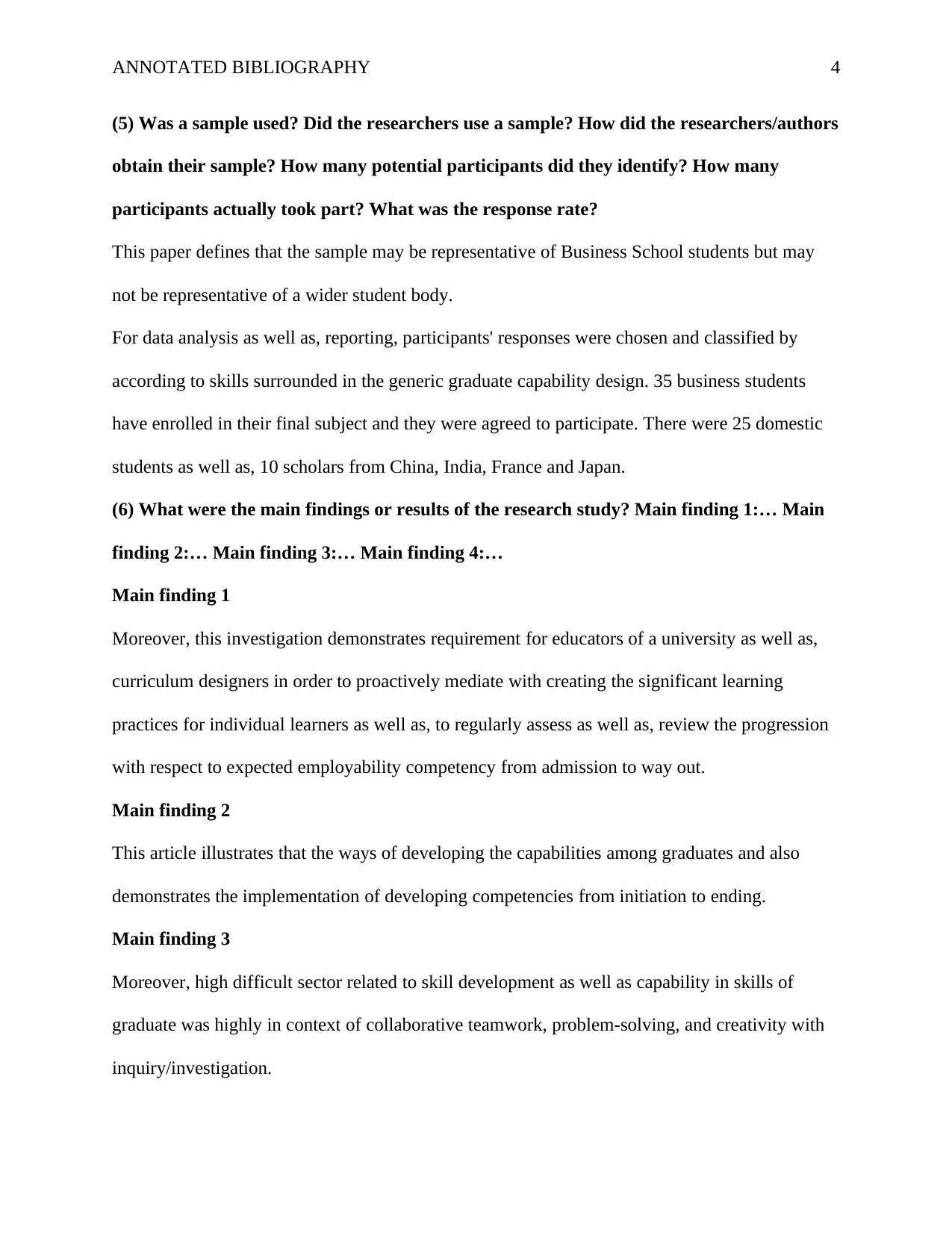
ANNOTATED BIBLIOGRAPHY 4
(5) Was a sample used? Did the researchers use a sample? How did the researchers/authors
obtain their sample? How many potential participants did they identify? How many
participants actually took part? What was the response rate?
This paper defines that the sample may be representative of Business School students but may
not be representative of a wider student body.
For data analysis as well as, reporting, participants' responses were chosen and classified by
according to skills surrounded in the generic graduate capability design. 35 business students
have enrolled in their final subject and they were agreed to participate. There were 25 domestic
students as well as, 10 scholars from China, India, France and Japan.
(6) What were the main findings or results of the research study? Main finding 1:… Main
finding 2:… Main finding 3:… Main finding 4:…
Main finding 1
Moreover, this investigation demonstrates requirement for educators of a university as well as,
curriculum designers in order to proactively mediate with creating the significant learning
practices for individual learners as well as, to regularly assess as well as, review the progression
with respect to expected employability competency from admission to way out.
Main finding 2
This article illustrates that the ways of developing the capabilities among graduates and also
demonstrates the implementation of developing competencies from initiation to ending.
Main finding 3
Moreover, high difficult sector related to skill development as well as capability in skills of
graduate was highly in context of collaborative teamwork, problem-solving, and creativity with
inquiry/investigation.
(5) Was a sample used? Did the researchers use a sample? How did the researchers/authors
obtain their sample? How many potential participants did they identify? How many
participants actually took part? What was the response rate?
This paper defines that the sample may be representative of Business School students but may
not be representative of a wider student body.
For data analysis as well as, reporting, participants' responses were chosen and classified by
according to skills surrounded in the generic graduate capability design. 35 business students
have enrolled in their final subject and they were agreed to participate. There were 25 domestic
students as well as, 10 scholars from China, India, France and Japan.
(6) What were the main findings or results of the research study? Main finding 1:… Main
finding 2:… Main finding 3:… Main finding 4:…
Main finding 1
Moreover, this investigation demonstrates requirement for educators of a university as well as,
curriculum designers in order to proactively mediate with creating the significant learning
practices for individual learners as well as, to regularly assess as well as, review the progression
with respect to expected employability competency from admission to way out.
Main finding 2
This article illustrates that the ways of developing the capabilities among graduates and also
demonstrates the implementation of developing competencies from initiation to ending.
Main finding 3
Moreover, high difficult sector related to skill development as well as capability in skills of
graduate was highly in context of collaborative teamwork, problem-solving, and creativity with
inquiry/investigation.
Paraphrase This Document
Need a fresh take? Get an instant paraphrase of this document with our AI Paraphraser
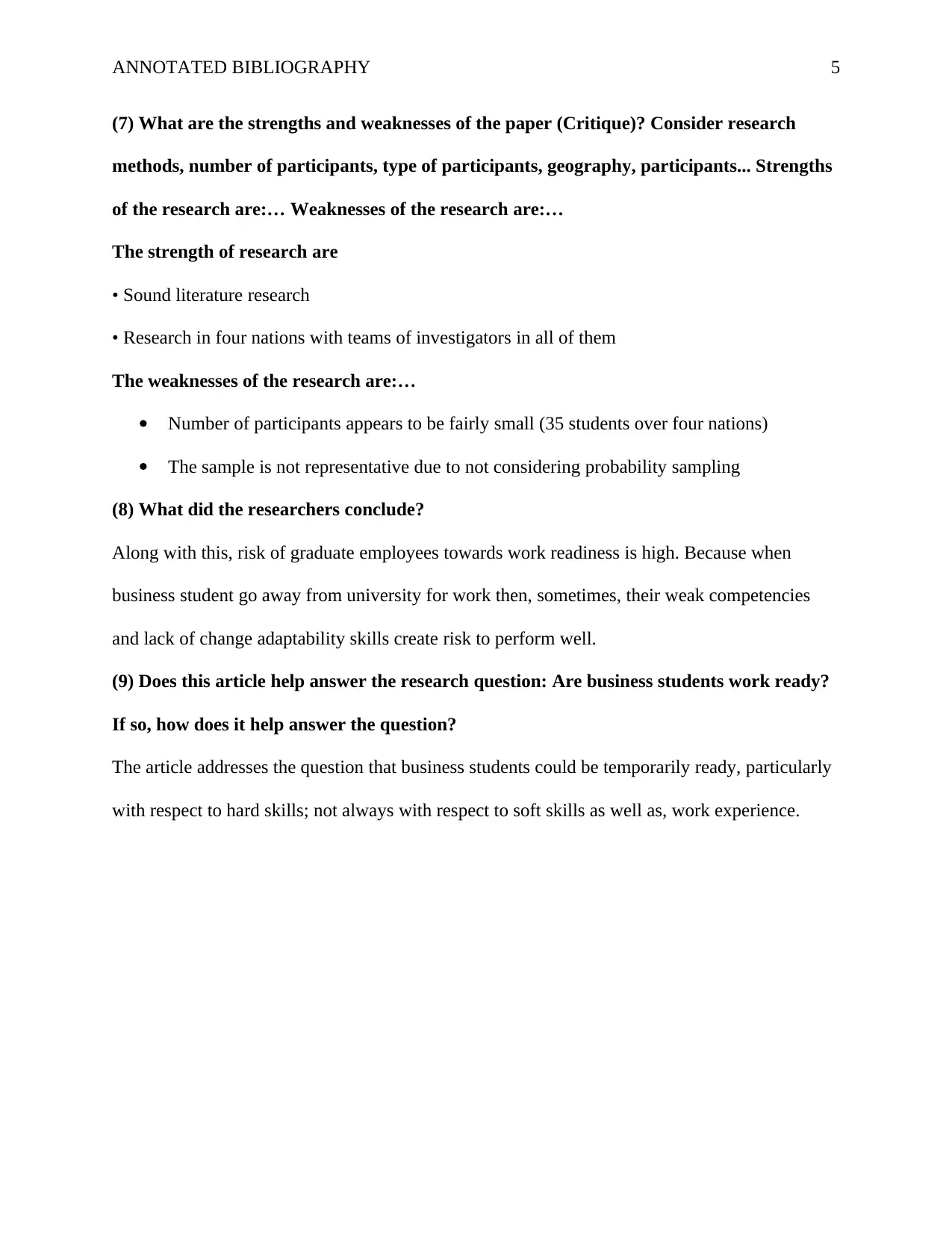
ANNOTATED BIBLIOGRAPHY 5
(7) What are the strengths and weaknesses of the paper (Critique)? Consider research
methods, number of participants, type of participants, geography, participants... Strengths
of the research are:… Weaknesses of the research are:…
The strength of research are
• Sound literature research
• Research in four nations with teams of investigators in all of them
The weaknesses of the research are:…
Number of participants appears to be fairly small (35 students over four nations)
The sample is not representative due to not considering probability sampling
(8) What did the researchers conclude?
Along with this, risk of graduate employees towards work readiness is high. Because when
business student go away from university for work then, sometimes, their weak competencies
and lack of change adaptability skills create risk to perform well.
(9) Does this article help answer the research question: Are business students work ready?
If so, how does it help answer the question?
The article addresses the question that business students could be temporarily ready, particularly
with respect to hard skills; not always with respect to soft skills as well as, work experience.
(7) What are the strengths and weaknesses of the paper (Critique)? Consider research
methods, number of participants, type of participants, geography, participants... Strengths
of the research are:… Weaknesses of the research are:…
The strength of research are
• Sound literature research
• Research in four nations with teams of investigators in all of them
The weaknesses of the research are:…
Number of participants appears to be fairly small (35 students over four nations)
The sample is not representative due to not considering probability sampling
(8) What did the researchers conclude?
Along with this, risk of graduate employees towards work readiness is high. Because when
business student go away from university for work then, sometimes, their weak competencies
and lack of change adaptability skills create risk to perform well.
(9) Does this article help answer the research question: Are business students work ready?
If so, how does it help answer the question?
The article addresses the question that business students could be temporarily ready, particularly
with respect to hard skills; not always with respect to soft skills as well as, work experience.
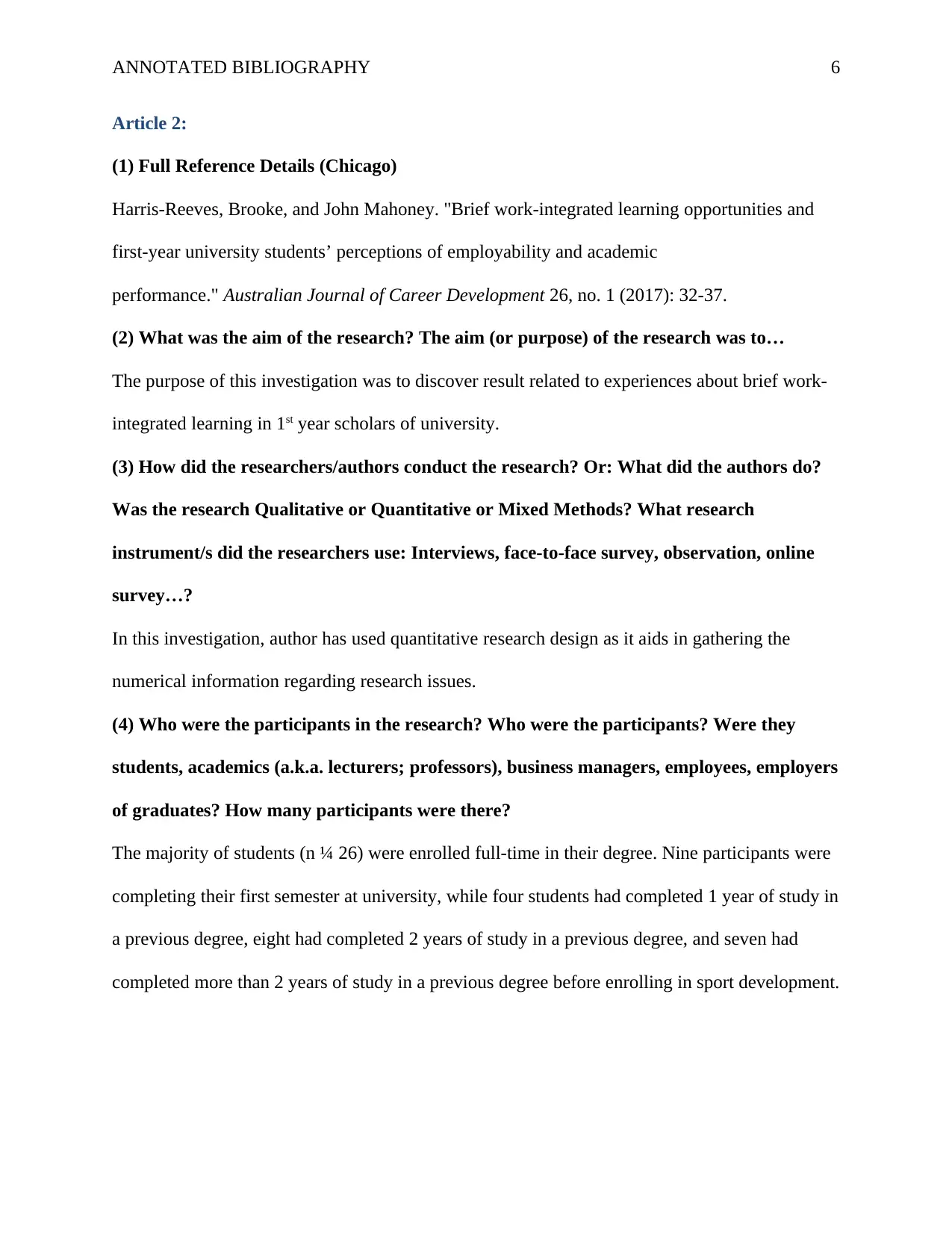
ANNOTATED BIBLIOGRAPHY 6
Article 2:
(1) Full Reference Details (Chicago)
Harris-Reeves, Brooke, and John Mahoney. "Brief work-integrated learning opportunities and
first-year university students’ perceptions of employability and academic
performance." Australian Journal of Career Development 26, no. 1 (2017): 32-37.
(2) What was the aim of the research? The aim (or purpose) of the research was to…
The purpose of this investigation was to discover result related to experiences about brief work-
integrated learning in 1st year scholars of university.
(3) How did the researchers/authors conduct the research? Or: What did the authors do?
Was the research Qualitative or Quantitative or Mixed Methods? What research
instrument/s did the researchers use: Interviews, face-to-face survey, observation, online
survey…?
In this investigation, author has used quantitative research design as it aids in gathering the
numerical information regarding research issues.
(4) Who were the participants in the research? Who were the participants? Were they
students, academics (a.k.a. lecturers; professors), business managers, employees, employers
of graduates? How many participants were there?
The majority of students (n ¼ 26) were enrolled full-time in their degree. Nine participants were
completing their first semester at university, while four students had completed 1 year of study in
a previous degree, eight had completed 2 years of study in a previous degree, and seven had
completed more than 2 years of study in a previous degree before enrolling in sport development.
Article 2:
(1) Full Reference Details (Chicago)
Harris-Reeves, Brooke, and John Mahoney. "Brief work-integrated learning opportunities and
first-year university students’ perceptions of employability and academic
performance." Australian Journal of Career Development 26, no. 1 (2017): 32-37.
(2) What was the aim of the research? The aim (or purpose) of the research was to…
The purpose of this investigation was to discover result related to experiences about brief work-
integrated learning in 1st year scholars of university.
(3) How did the researchers/authors conduct the research? Or: What did the authors do?
Was the research Qualitative or Quantitative or Mixed Methods? What research
instrument/s did the researchers use: Interviews, face-to-face survey, observation, online
survey…?
In this investigation, author has used quantitative research design as it aids in gathering the
numerical information regarding research issues.
(4) Who were the participants in the research? Who were the participants? Were they
students, academics (a.k.a. lecturers; professors), business managers, employees, employers
of graduates? How many participants were there?
The majority of students (n ¼ 26) were enrolled full-time in their degree. Nine participants were
completing their first semester at university, while four students had completed 1 year of study in
a previous degree, eight had completed 2 years of study in a previous degree, and seven had
completed more than 2 years of study in a previous degree before enrolling in sport development.
⊘ This is a preview!⊘
Do you want full access?
Subscribe today to unlock all pages.

Trusted by 1+ million students worldwide
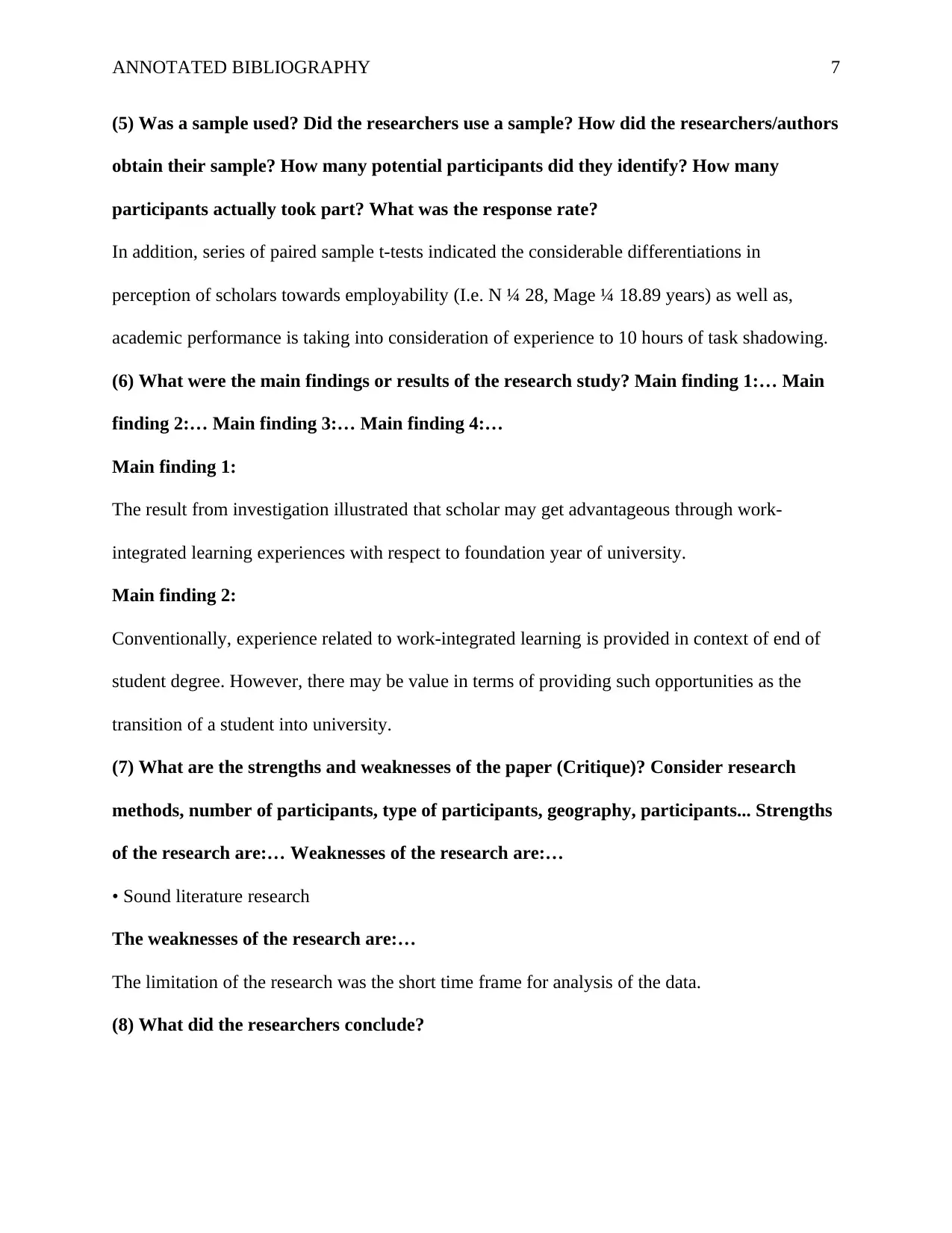
ANNOTATED BIBLIOGRAPHY 7
(5) Was a sample used? Did the researchers use a sample? How did the researchers/authors
obtain their sample? How many potential participants did they identify? How many
participants actually took part? What was the response rate?
In addition, series of paired sample t-tests indicated the considerable differentiations in
perception of scholars towards employability (I.e. N ¼ 28, Mage ¼ 18.89 years) as well as,
academic performance is taking into consideration of experience to 10 hours of task shadowing.
(6) What were the main findings or results of the research study? Main finding 1:… Main
finding 2:… Main finding 3:… Main finding 4:…
Main finding 1:
The result from investigation illustrated that scholar may get advantageous through work-
integrated learning experiences with respect to foundation year of university.
Main finding 2:
Conventionally, experience related to work-integrated learning is provided in context of end of
student degree. However, there may be value in terms of providing such opportunities as the
transition of a student into university.
(7) What are the strengths and weaknesses of the paper (Critique)? Consider research
methods, number of participants, type of participants, geography, participants... Strengths
of the research are:… Weaknesses of the research are:…
• Sound literature research
The weaknesses of the research are:…
The limitation of the research was the short time frame for analysis of the data.
(8) What did the researchers conclude?
(5) Was a sample used? Did the researchers use a sample? How did the researchers/authors
obtain their sample? How many potential participants did they identify? How many
participants actually took part? What was the response rate?
In addition, series of paired sample t-tests indicated the considerable differentiations in
perception of scholars towards employability (I.e. N ¼ 28, Mage ¼ 18.89 years) as well as,
academic performance is taking into consideration of experience to 10 hours of task shadowing.
(6) What were the main findings or results of the research study? Main finding 1:… Main
finding 2:… Main finding 3:… Main finding 4:…
Main finding 1:
The result from investigation illustrated that scholar may get advantageous through work-
integrated learning experiences with respect to foundation year of university.
Main finding 2:
Conventionally, experience related to work-integrated learning is provided in context of end of
student degree. However, there may be value in terms of providing such opportunities as the
transition of a student into university.
(7) What are the strengths and weaknesses of the paper (Critique)? Consider research
methods, number of participants, type of participants, geography, participants... Strengths
of the research are:… Weaknesses of the research are:…
• Sound literature research
The weaknesses of the research are:…
The limitation of the research was the short time frame for analysis of the data.
(8) What did the researchers conclude?
Paraphrase This Document
Need a fresh take? Get an instant paraphrase of this document with our AI Paraphraser
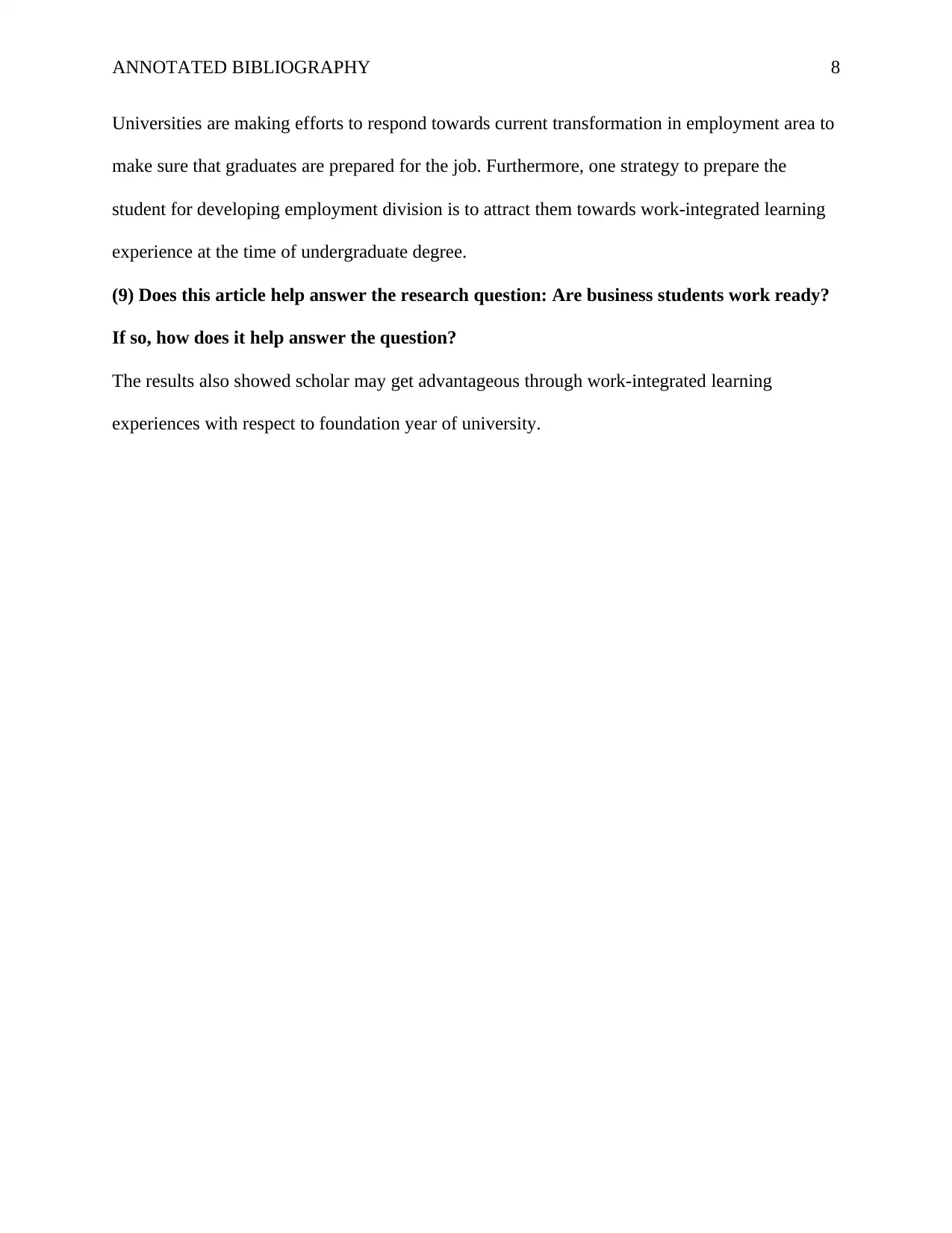
ANNOTATED BIBLIOGRAPHY 8
Universities are making efforts to respond towards current transformation in employment area to
make sure that graduates are prepared for the job. Furthermore, one strategy to prepare the
student for developing employment division is to attract them towards work-integrated learning
experience at the time of undergraduate degree.
(9) Does this article help answer the research question: Are business students work ready?
If so, how does it help answer the question?
The results also showed scholar may get advantageous through work-integrated learning
experiences with respect to foundation year of university.
Universities are making efforts to respond towards current transformation in employment area to
make sure that graduates are prepared for the job. Furthermore, one strategy to prepare the
student for developing employment division is to attract them towards work-integrated learning
experience at the time of undergraduate degree.
(9) Does this article help answer the research question: Are business students work ready?
If so, how does it help answer the question?
The results also showed scholar may get advantageous through work-integrated learning
experiences with respect to foundation year of university.
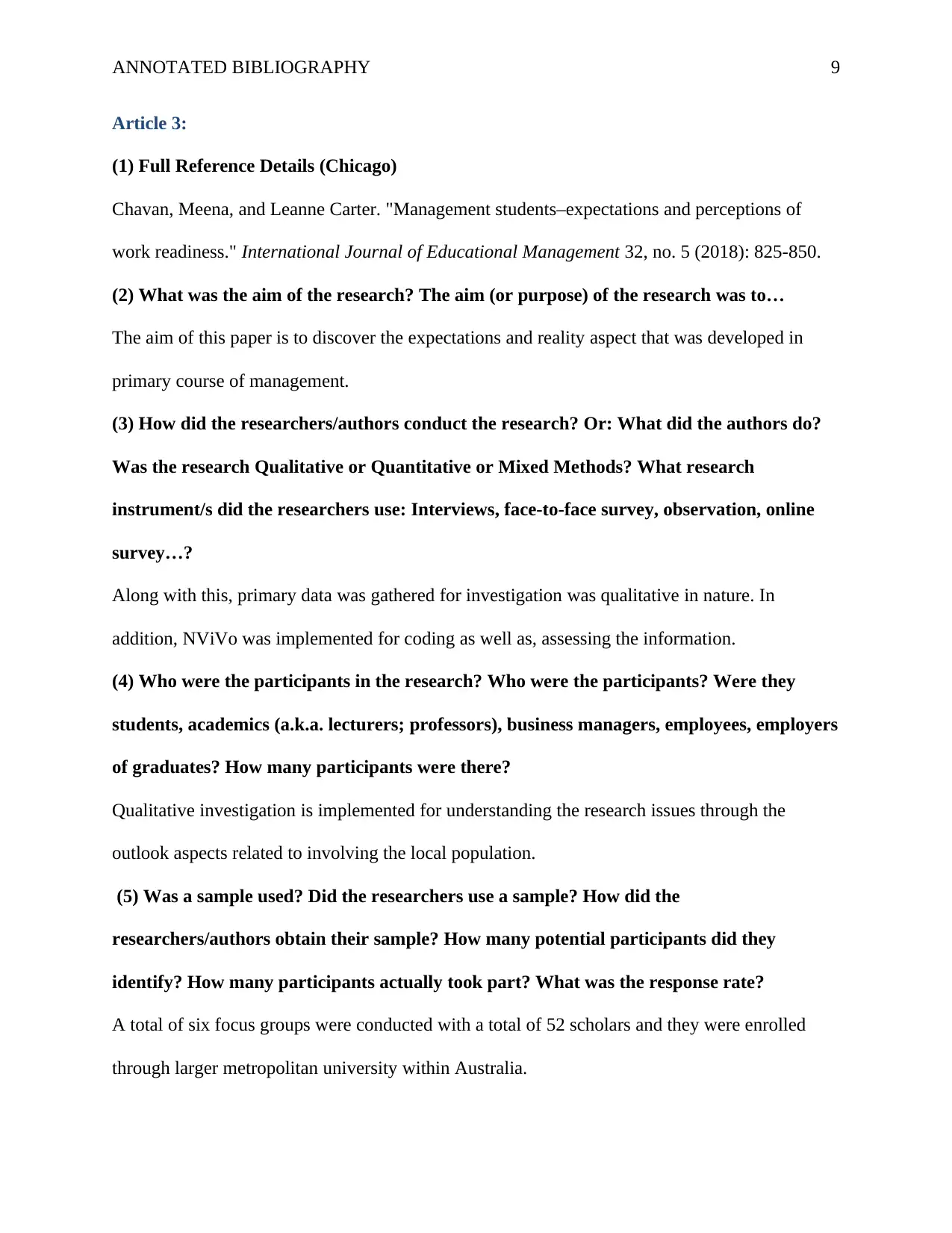
ANNOTATED BIBLIOGRAPHY 9
Article 3:
(1) Full Reference Details (Chicago)
Chavan, Meena, and Leanne Carter. "Management students–expectations and perceptions of
work readiness." International Journal of Educational Management 32, no. 5 (2018): 825-850.
(2) What was the aim of the research? The aim (or purpose) of the research was to…
The aim of this paper is to discover the expectations and reality aspect that was developed in
primary course of management.
(3) How did the researchers/authors conduct the research? Or: What did the authors do?
Was the research Qualitative or Quantitative or Mixed Methods? What research
instrument/s did the researchers use: Interviews, face-to-face survey, observation, online
survey…?
Along with this, primary data was gathered for investigation was qualitative in nature. In
addition, NViVo was implemented for coding as well as, assessing the information.
(4) Who were the participants in the research? Who were the participants? Were they
students, academics (a.k.a. lecturers; professors), business managers, employees, employers
of graduates? How many participants were there?
Qualitative investigation is implemented for understanding the research issues through the
outlook aspects related to involving the local population.
(5) Was a sample used? Did the researchers use a sample? How did the
researchers/authors obtain their sample? How many potential participants did they
identify? How many participants actually took part? What was the response rate?
A total of six focus groups were conducted with a total of 52 scholars and they were enrolled
through larger metropolitan university within Australia.
Article 3:
(1) Full Reference Details (Chicago)
Chavan, Meena, and Leanne Carter. "Management students–expectations and perceptions of
work readiness." International Journal of Educational Management 32, no. 5 (2018): 825-850.
(2) What was the aim of the research? The aim (or purpose) of the research was to…
The aim of this paper is to discover the expectations and reality aspect that was developed in
primary course of management.
(3) How did the researchers/authors conduct the research? Or: What did the authors do?
Was the research Qualitative or Quantitative or Mixed Methods? What research
instrument/s did the researchers use: Interviews, face-to-face survey, observation, online
survey…?
Along with this, primary data was gathered for investigation was qualitative in nature. In
addition, NViVo was implemented for coding as well as, assessing the information.
(4) Who were the participants in the research? Who were the participants? Were they
students, academics (a.k.a. lecturers; professors), business managers, employees, employers
of graduates? How many participants were there?
Qualitative investigation is implemented for understanding the research issues through the
outlook aspects related to involving the local population.
(5) Was a sample used? Did the researchers use a sample? How did the
researchers/authors obtain their sample? How many potential participants did they
identify? How many participants actually took part? What was the response rate?
A total of six focus groups were conducted with a total of 52 scholars and they were enrolled
through larger metropolitan university within Australia.
⊘ This is a preview!⊘
Do you want full access?
Subscribe today to unlock all pages.

Trusted by 1+ million students worldwide
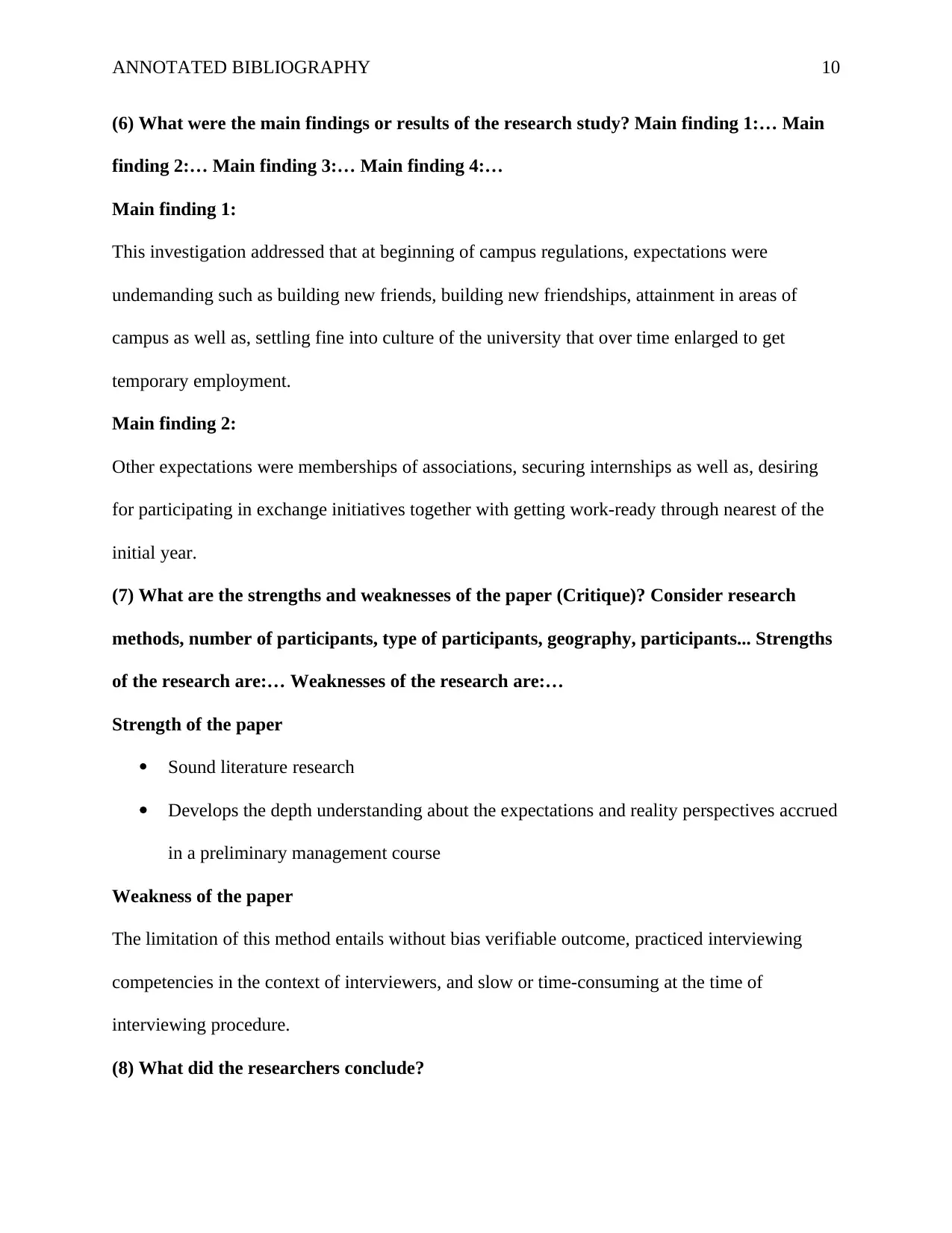
ANNOTATED BIBLIOGRAPHY 10
(6) What were the main findings or results of the research study? Main finding 1:… Main
finding 2:… Main finding 3:… Main finding 4:…
Main finding 1:
This investigation addressed that at beginning of campus regulations, expectations were
undemanding such as building new friends, building new friendships, attainment in areas of
campus as well as, settling fine into culture of the university that over time enlarged to get
temporary employment.
Main finding 2:
Other expectations were memberships of associations, securing internships as well as, desiring
for participating in exchange initiatives together with getting work-ready through nearest of the
initial year.
(7) What are the strengths and weaknesses of the paper (Critique)? Consider research
methods, number of participants, type of participants, geography, participants... Strengths
of the research are:… Weaknesses of the research are:…
Strength of the paper
Sound literature research
Develops the depth understanding about the expectations and reality perspectives accrued
in a preliminary management course
Weakness of the paper
The limitation of this method entails without bias verifiable outcome, practiced interviewing
competencies in the context of interviewers, and slow or time-consuming at the time of
interviewing procedure.
(8) What did the researchers conclude?
(6) What were the main findings or results of the research study? Main finding 1:… Main
finding 2:… Main finding 3:… Main finding 4:…
Main finding 1:
This investigation addressed that at beginning of campus regulations, expectations were
undemanding such as building new friends, building new friendships, attainment in areas of
campus as well as, settling fine into culture of the university that over time enlarged to get
temporary employment.
Main finding 2:
Other expectations were memberships of associations, securing internships as well as, desiring
for participating in exchange initiatives together with getting work-ready through nearest of the
initial year.
(7) What are the strengths and weaknesses of the paper (Critique)? Consider research
methods, number of participants, type of participants, geography, participants... Strengths
of the research are:… Weaknesses of the research are:…
Strength of the paper
Sound literature research
Develops the depth understanding about the expectations and reality perspectives accrued
in a preliminary management course
Weakness of the paper
The limitation of this method entails without bias verifiable outcome, practiced interviewing
competencies in the context of interviewers, and slow or time-consuming at the time of
interviewing procedure.
(8) What did the researchers conclude?
Paraphrase This Document
Need a fresh take? Get an instant paraphrase of this document with our AI Paraphraser
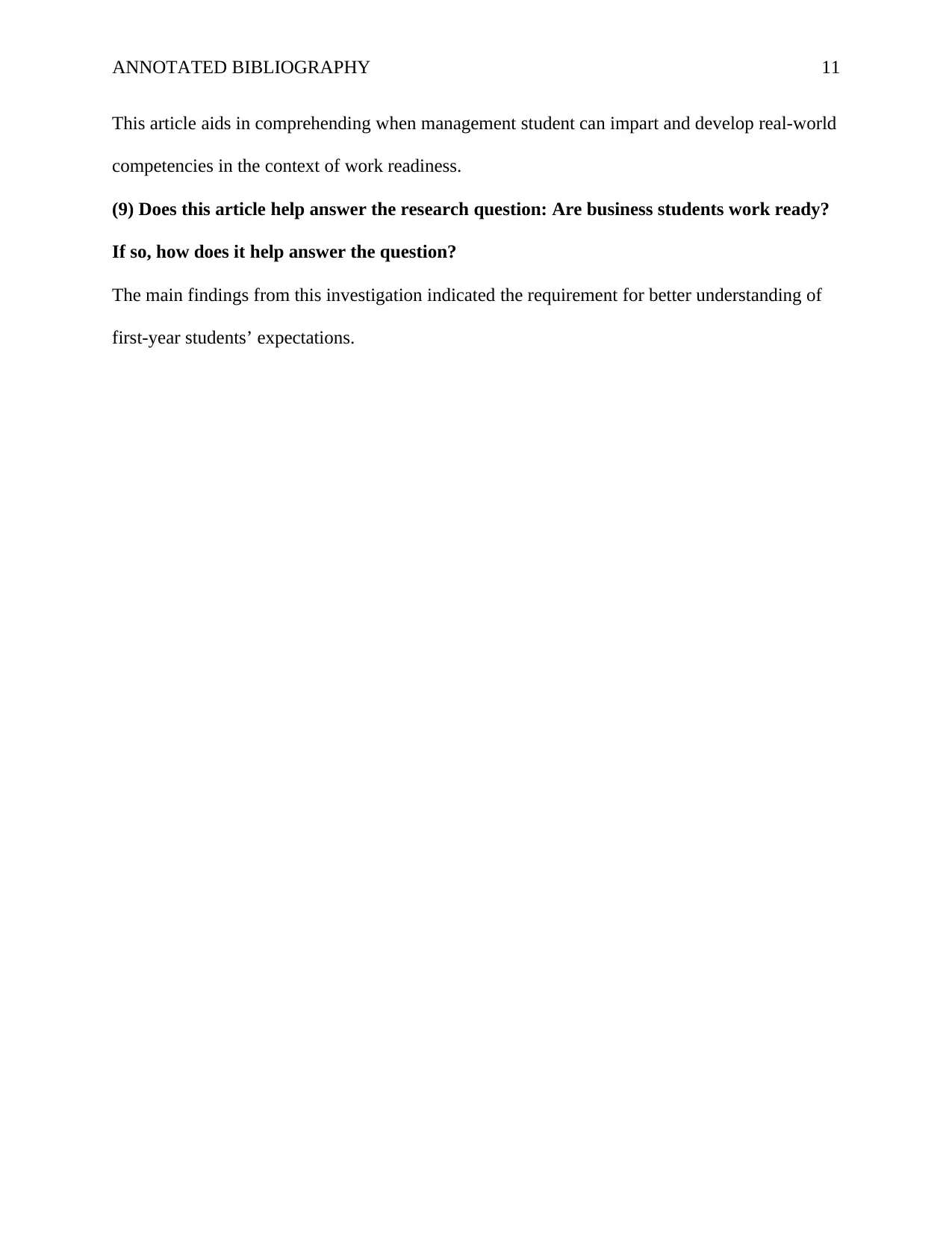
ANNOTATED BIBLIOGRAPHY 11
This article aids in comprehending when management student can impart and develop real-world
competencies in the context of work readiness.
(9) Does this article help answer the research question: Are business students work ready?
If so, how does it help answer the question?
The main findings from this investigation indicated the requirement for better understanding of
first-year students’ expectations.
This article aids in comprehending when management student can impart and develop real-world
competencies in the context of work readiness.
(9) Does this article help answer the research question: Are business students work ready?
If so, how does it help answer the question?
The main findings from this investigation indicated the requirement for better understanding of
first-year students’ expectations.
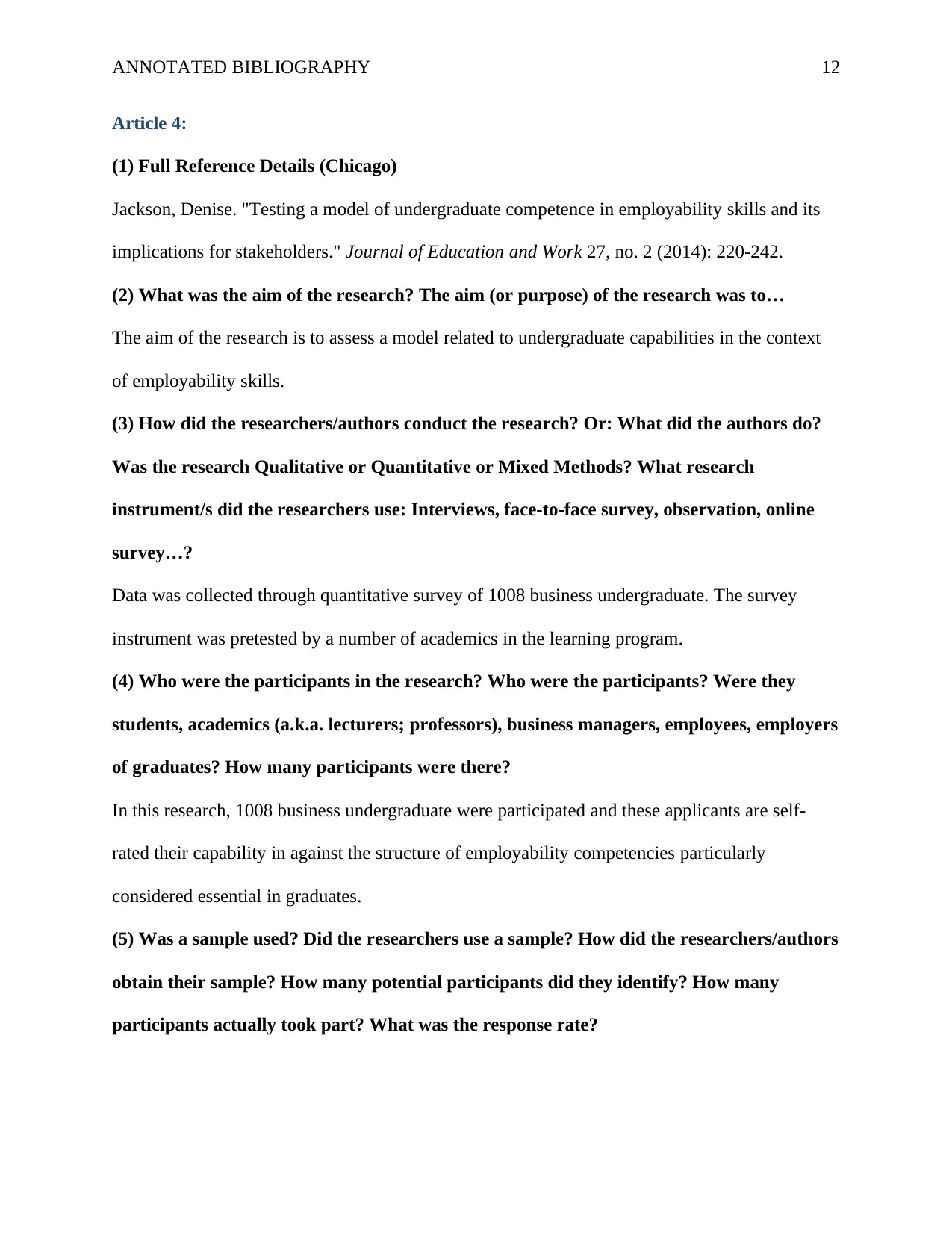
ANNOTATED BIBLIOGRAPHY 12
Article 4:
(1) Full Reference Details (Chicago)
Jackson, Denise. "Testing a model of undergraduate competence in employability skills and its
implications for stakeholders." Journal of Education and Work 27, no. 2 (2014): 220-242.
(2) What was the aim of the research? The aim (or purpose) of the research was to…
The aim of the research is to assess a model related to undergraduate capabilities in the context
of employability skills.
(3) How did the researchers/authors conduct the research? Or: What did the authors do?
Was the research Qualitative or Quantitative or Mixed Methods? What research
instrument/s did the researchers use: Interviews, face-to-face survey, observation, online
survey…?
Data was collected through quantitative survey of 1008 business undergraduate. The survey
instrument was pretested by a number of academics in the learning program.
(4) Who were the participants in the research? Who were the participants? Were they
students, academics (a.k.a. lecturers; professors), business managers, employees, employers
of graduates? How many participants were there?
In this research, 1008 business undergraduate were participated and these applicants are self-
rated their capability in against the structure of employability competencies particularly
considered essential in graduates.
(5) Was a sample used? Did the researchers use a sample? How did the researchers/authors
obtain their sample? How many potential participants did they identify? How many
participants actually took part? What was the response rate?
Article 4:
(1) Full Reference Details (Chicago)
Jackson, Denise. "Testing a model of undergraduate competence in employability skills and its
implications for stakeholders." Journal of Education and Work 27, no. 2 (2014): 220-242.
(2) What was the aim of the research? The aim (or purpose) of the research was to…
The aim of the research is to assess a model related to undergraduate capabilities in the context
of employability skills.
(3) How did the researchers/authors conduct the research? Or: What did the authors do?
Was the research Qualitative or Quantitative or Mixed Methods? What research
instrument/s did the researchers use: Interviews, face-to-face survey, observation, online
survey…?
Data was collected through quantitative survey of 1008 business undergraduate. The survey
instrument was pretested by a number of academics in the learning program.
(4) Who were the participants in the research? Who were the participants? Were they
students, academics (a.k.a. lecturers; professors), business managers, employees, employers
of graduates? How many participants were there?
In this research, 1008 business undergraduate were participated and these applicants are self-
rated their capability in against the structure of employability competencies particularly
considered essential in graduates.
(5) Was a sample used? Did the researchers use a sample? How did the researchers/authors
obtain their sample? How many potential participants did they identify? How many
participants actually took part? What was the response rate?
⊘ This is a preview!⊘
Do you want full access?
Subscribe today to unlock all pages.

Trusted by 1+ million students worldwide
1 out of 18
Related Documents
Your All-in-One AI-Powered Toolkit for Academic Success.
+13062052269
info@desklib.com
Available 24*7 on WhatsApp / Email
![[object Object]](/_next/static/media/star-bottom.7253800d.svg)
Unlock your academic potential
Copyright © 2020–2025 A2Z Services. All Rights Reserved. Developed and managed by ZUCOL.





